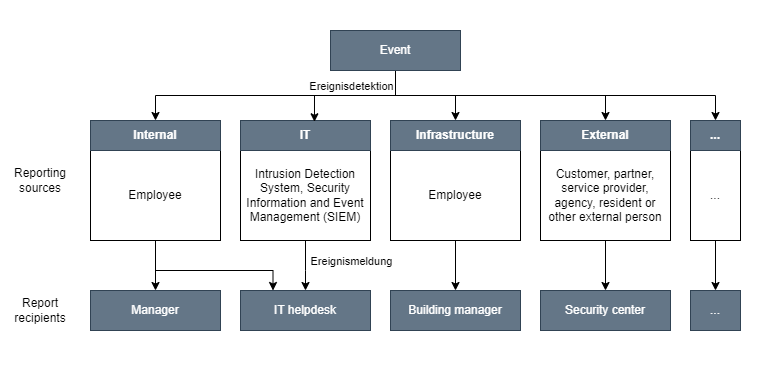Demo writer (talk | contribs) (Created page with "== Detection and reporting == The initial assessment of a damaging event takes place in the reporting offices. The reporting offices can use the following key questions to ass...") |
Demo writer (talk | contribs) No edit summary |
||
| (2 intermediate revisions by the same user not shown) | |||
| Line 1: | Line 1: | ||
<bookshelf src="Book:Emergency Manual" /> | |||
== Detection and reporting == | == Detection and reporting == | ||
The initial assessment of a damaging event takes place in the reporting offices. The reporting offices can use the following key questions to assess whether the event has emergency or crisis potential. If the damage event is classified as a potential emergency or crisis, the central decision-making body must be alerted. If the reporting office classifies the event as a disruption, which could develop into an emergency or a crisis, the central decision-making body should be informed and the disruption should be monitored. | The initial assessment of a damaging event takes place in the reporting offices. The reporting offices can use the following key questions to assess whether the event has emergency or crisis potential. If the damage event is classified as a potential emergency or crisis, the central decision-making body must be alerted. If the reporting office classifies the event as a disruption, which could develop into an emergency or a crisis, the central decision-making body should be informed and the disruption should be monitored. | ||
<span><br /></span> | |||
<bs:drawio filename="EHB-Reporting" /> | |||
Figure 1 can be obtained as an editable version as an aid from the BSI. | |||
<span><br /></span> | |||
==Detection and reporting== | |||
The first assessment of a damaging event takes place in the reporting offices. The reporting offices can use the following key questions to assess whether the event has the potential for an emergency or crisis. If the damage event is classified as a potential emergency or crisis, the central decision-making body must be alerted. If the reporting office classifies the event as an incident that could develop into an emergency or crisis, the central decision-making body should be informed and the incident monitored further. | |||
<span><span /><br /></span> | |||
__FORCETOC__ | |||
Latest revision as of 09:38, 3 February 2023
3.1. Detection and reporting
The initial assessment of a damaging event takes place in the reporting offices. The reporting offices can use the following key questions to assess whether the event has emergency or crisis potential. If the damage event is classified as a potential emergency or crisis, the central decision-making body must be alerted. If the reporting office classifies the event as a disruption, which could develop into an emergency or a crisis, the central decision-making body should be informed and the disruption should be monitored.
Figure 1 can be obtained as an editable version as an aid from the BSI.
3.2. Detection and reporting
The first assessment of a damaging event takes place in the reporting offices. The reporting offices can use the following key questions to assess whether the event has the potential for an emergency or crisis. If the damage event is classified as a potential emergency or crisis, the central decision-making body must be alerted. If the reporting office classifies the event as an incident that could develop into an emergency or crisis, the central decision-making body should be informed and the incident monitored further.

Discussions